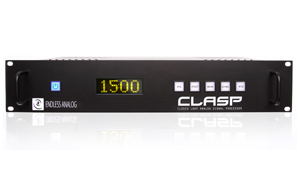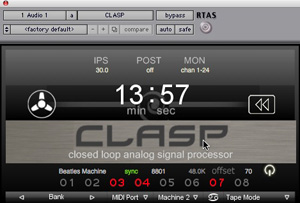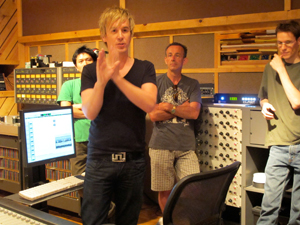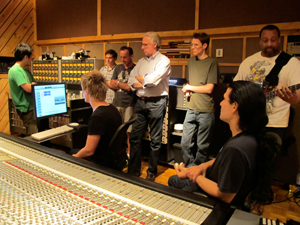Endless Analog Demos Its Dream-Come-True CLASP at Avatar
MIDTOWN MANHATTAN: Nashville-based producer/musician/inventor Chris Estes demonstrated his revolutionary Endless Analog CLASP system in Avatar’s Studio G on Monday. The session featured ace-of-bass and producer Jerry Barnes tracking some tasty bass grooves to Pro Tools HD via 2” tape and the CLASP.
Since the CLASP is such a newfangled, first-of-its-kind product, there’s a lot to understand about what it does and how it works. There are several great reviews and testimonials on the system here and plenty of information to answer any and all questions you may have. But here’s the gist:
CLASP (Closed Loop Analog Signal Processor) consists of a hardware unit that is installed between your mic pre’s, DAW and tape machine, and the native Bridge plug-in (RTAS and VST), which you open on any track in your DAW session and use to control the tape transport.
These days, most recordings being done to tape are then dumped into the digital realm for editing and mixing. CLASP allows for a totally hybrid workflow, where analog recording and overdubs are done in real time, controlled with the speed and efficiency of digital, and all audio is stored in your DAW, minimizing tape usage. You can use one reel of tape to record an entire album, or several albums for that matter.
CLASP essentially allows the tape machine to be used like a plug-in. You control the tape machine and switch between tape speeds stored in the CLASP right from your DAW. And you can monitor analog in repro mode. [See the CLASP connection diagram here.]
The elevator pitch to engineers via Endless Analog’s website: “CLASP provides sample accurate tape synchronization with zero latency analog monitoring while delivering a true analog front end recording solution for Pro Tools.”
Seeing the CLASP in action, its functionality seems instantly essential. It totally streamlines a process that needs streamlining and will allow so many more people to utilize analog tape as part of their production.
At Avatar, the CLASP hardware unit was connected via MIDI to the Pro Tools HD rig and through an Endless Analog proprietary cable to the 24-track Studer A800. Once the tape machine was aligned and synchronized to the Pro Tools session at both 15 ips and 30 ips recording speeds via CLASP, Barnes tracked a bass line and then monitored off the repro head to select his preferred speed.
During playback, Estes pointed out: “Being able to monitor in repro is a really great thing for getting drum sounds, for example, because you can make judgment calls about what tape speed you want to use for a particular song.”
“You can have it on whatever speed and then have the drummer play, mute his headphones, and then listen off the tape in Pro Tools. And you can make decisions about levels and EQ and things like that based on what you’re hearing.
“You can have the tape rolling while the drummer’s playing and, starting with the kick drum, you can bring the level up to find the sweet spot — right where we get just the right amount of tape compression — and dial it in so when you go to do your recordings, there are no surprises.”
CLASP stores information for up to three different recording speeds. Estes relayed to the group: “In a lot of sessions we’ve done so far, people will record the drums at 30 ips, then they’ll go back and re-cut the bass at 15. Then they’ll cut electric guitars at 7½, which sounds really great if the machine is aligned properly. With this [A800] machine, you’d vari-speed it down as far as you can get it and then do an alignment for that.”
“And if you wanted to use varispeed to overdub just a Tom Fill at 15IPS and have the rest at 30?” engineer Roy Hendrickson asked.
“You’d use the sync I/O in Pro Tools and vari-speed Pro Tools up,” says Estes. “So to make the toms sound bigger you’d vari-speed Pro Tools up and do the tom fill, put it back normal, and then the toms would be huge.”
Estes also points out you can daisy-chain up to three CLASP hardware interfaces and synchronize three 24-track tape machines for a total of 72-channels of recording. You can use CLASP with 24, 16, 8 or even 2-track machines, you can combine different machines and tape speeds for different tones. In addition to Pro Tools, CLASP also works with Nuendo and Cubase.
But there’s even more to know…here’s Estes on-the-spot rundown of CLASP’s main functions and features:
1) First of all, the CLASP is a precision measuring instrument, which functions as a sample-accurate synchronization device, so it’s able to profile the tape machine, analyze the ballistics of the machine, calculate to the sample what the latency of that machine is — taking into consideration the transport, the flutter, etc. Then, it’s telling Pro Tools to change the time stamp of the audio that’s coming into the converters.
So, while you’re recording, the meters are actually late but then when you watch the wave forms as they’re going down, Pro Tools is drawing them in relationship to the grid in the correct time. So it’s an actual time stamp, you can take the session to another studio and you don’t have to have the CLASP. You only use the CLASP when you’re cutting tracks.
2) The CLASP is seamlessly controlling the tape transport for you invisibly in the background. It works a lot like the Quick Punch mode — it looks at the track-arming status and as soon as you have tracks armed and you start the Pro Tools transport, the CLASP, analog machine and Pro Tools Quick Punch all start recording simultaneously in the background. It’s extrapolating from the Pro Tools transport and track-arming status. So even though you might have punched in late, you can peel back audio with tape now. Which is impossible otherwise.
3) You don’t have to rewind the tape until you reach the end of the reel. In this case, it’s counting down from 30 minutes (@15 IPS), so you’d only have to rewind every half-hour or so.
4) You now have latency-free analog monitoring. We’re monitoring here through the master-grade analog hardware of the CLASP, not Pro Tools.
5) CLASP compensates for the converter delay times. If you’re using Apogee 16X converters with Pro Tools, for example, that’s 62 samples of converter latency at 44.1, so you simply type in 62 samples in the offset and then everything you play is perfectly in time with where it’s supposed to be when you play it back.
After the demo at Avatar, engineer Roy Hendrickson shared his impressions with us:
“I think what Chris has done here is quite brilliant. The fact that he is getting Pro Tools to record these files into the DAW with an adjusted time stamp is genius.
“And once you’re finished using CLASP and you go back to using Pro Tools normally, there are no side effects, there’s nothing you have to change about your workflow. You don’t have to move your files and it does all those little tweaks that you’d normally have to do — like re-compensating for things like delay manually — this takes care of all that for you in a really elegant manner so you don’t have to worry. You can concentrate on the performance.”
On the Endless Analog website, Chris Estes and Endless Analog VP Amy Becker Estes ask us to: “Imagine experiencing analog tape recording as fast, effortless and timesaving as Pro Tools.” The CLASP system, which Estes started developing out of his garage in Nashville over five years ago, makes this idea – once Estes’ daydream – a reality.
Endless Analog’s CLASP system is available now from Vintage King for $7,495.
Visit http://www.endlessanalog.com and http://www.vintageking.com/Endless-Analog-Clasp for more information!











charlie p
August 5, 2010 at 4:13 pm (14 years ago)this is a great concept and a must-have for any studio with an analog deck. i’ve seen a lot of people try to record to analog, going into the DAW off the repro heads. that works fine right up until you try to punch in or add something, which you almost always need to do!
Clasp should consider offering the system for $10k, including a free 24 track tape machine!
charlie p
August 5, 2010 at 9:13 am (14 years ago)this is a great concept and a must-have for any studio with an analog deck. i’ve seen a lot of people try to record to analog, going into the DAW off the repro heads. that works fine right up until you try to punch in or add something, which you almost always need to do!
Clasp should consider offering the system for $10k, including a free 24 track tape machine!
Pat McGrath
August 7, 2010 at 5:44 pm (14 years ago)I worked with Chris and The Clasp for an all day tracking session last month and it was a total pleasure. The sound of tape combined with the ease of pro-tools was making everyone very happy.
Pat McGrath
August 7, 2010 at 10:44 am (14 years ago)I worked with Chris and The Clasp for an all day tracking session last month and it was a total pleasure. The sound of tape combined with the ease of pro-tools was making everyone very happy.